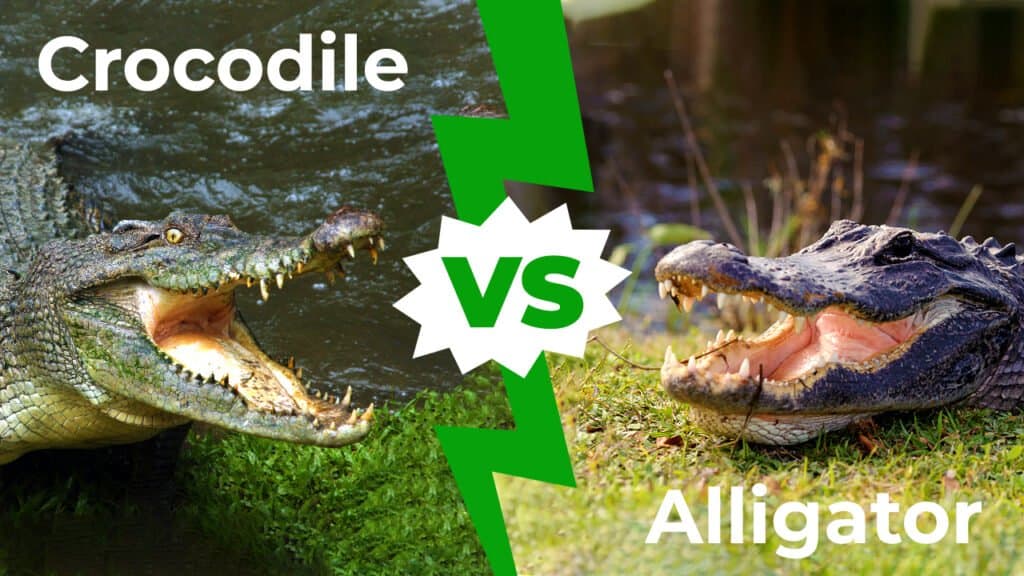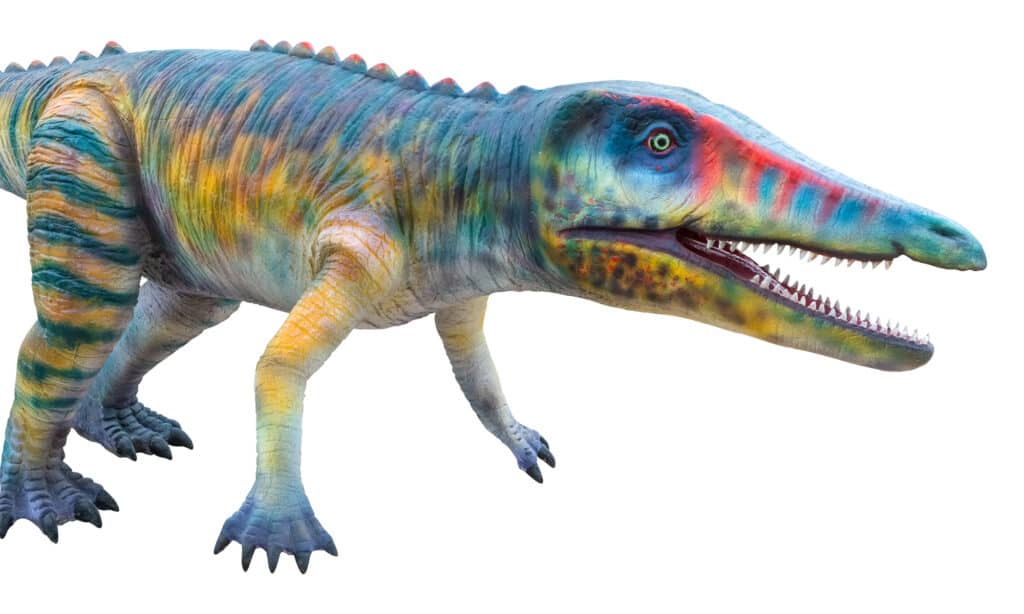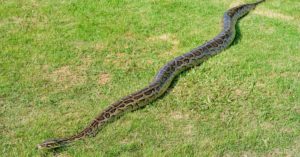Alligators are both amazing and terrifying with their powerful bodies and razor-sharp teeth, but do you know about some of the enormous extinct alligators that have prowled the planet? Here are five extinct alligators to keep you awake at night!
Before we begin, let’s explore what the difference between a crocodile and an alligator is.
What Is the Difference Between a Crocodile and an Alligator?
The main differences between crocodiles and alligators are:
- Alligators have broad U-shaped snouts
- Teeth are hidden when the mouth is closed
- They are grey or black compared to a croc’s olive or tan shade.
However, both species are reptiles that descended from the same scientific order. The order split millions of years ago, so now alligators are from the Alligatordae family and crocs from the Crocodylia family. Other members are caimans and gavialidae.
This means they had a common ancestor millions of years ago when they lived alongside the dinosaurs. Alligators and crocodiles survived because they are cold-blooded. When food sources became scarce after the catastrophic event that wiped out dinosaurs, they slowed their metabolisms and survived.

Now we know the difference, let’s discover five extinct alligators.
1. Deinosuchus

Deinosuchus was estimated to be up to 39 feet long, dwarfing the size of today’s alligators.
©Herschel Hoffmeyer/Shutterstock.com
The most famous extinct alligator is Deinosuchus (don’t confuse it with the therapod deinonychus). This huge reptile was an alligatoroid crocodilian that lived up to 73 million years ago in the late Cretaceous period.
It was up to 39 feet long and possibly the biggest river-dwelling animal that’s extinct. In fact, Deinosuchus was even longer than the tallest 30 feet high diving board in the Olympic Games.
Fossils found in North America and Mexico show Deinosuchus had a five feet long head and teeth the size of bananas. They were powerful and covered in thick skin, so Deinosuchus would have taken fish and turtles from its river habitat and was likely to have pounced on river-side dinosaurs too, much like modern-day alligators take drinking animals.
Its bite force is estimated at 20,000 pounds per square inch. That’s double the bite force of Tyrannosaurus Rex! Deinosuchus was a massive and hugely powerful extinct alligator.
2. Sarcosuchus imperator

Sarcosuchus imperator was about 31 feet long and weighed 4.2 tons.
©HombreDHojalata / CC BY-SA 3.0 – License
Sarcosuchus imperator lived between 133 million and 112 million years ago in the early Cretaceous before alligators and crocodiles split into their distinct families. Its name means “flesh crocodile” but this “supercroc” is classified as a pholidosaurid, which was a group of crocodile-like reptiles. Two species have been found: S. imperator in Africa and S. hartti from Brazil.
Paleontologists think Sarcosuchus grew to a massive 31 feet in length and weighed up to 4.2 tons. It had telescopic eyes to peer along the river’s surface while submerged, and a long snout with an overbite that took up at least 3/4ths of its skull. Sarcosuchus likely hunted fish such as the coelacanth and lepidotus as well as river-side dinosaurs, but recent research explained in this research from Historical Biology, suggests that unlike today’s alligators this monster couldn’t carry out a death roll.
Its fossils were first found in 1946 in Africa and South America in areas that were once fluvial and very tropical which allowed Sarcosuchus to reach such an incredible size. Climate change and a cooler environment may have led to this alligator relative’s extinction.
3. Brachychampsa
Brachychampsa was an ancient alligator relative that resembled a caiman. It lived 93.5 million to 63.3 million years ago in modern-day New Mexico, Colorado, North and South Dakota, and in Montana’s Hell Creek formation known for its abundant dinosaur remains.
Since 1911, experts have struggled to place Brachychampsa in a family order. It started off in the alligatoridae category, then moved to a subspecies, and even into the stem caiman family.
It had a short, blunt snout with pommel-capped teeth that specialized in breaking crustacean shells and other hard invertebrates. Brachychampsa was 10 feet long and smaller than other extinct alligators, but it was still a formidable predator with a powerful body covered in thick scaly skin.
4. Carnufex carolinensis

Carnufex is an extinct species of crocodylomorph that walked on two legs in the late Triassic age.
©YuRi Photolife/Shutterstock.com
Carnufex, also known as the “Carolina Butcher,” lived 237 million to 228 million years ago in the Late Triassic age. It was a crocodylomorph and a different type of extinct alligator relative because it was a biped that walked upright on two back legs.
This extinct genus of crocodylomorph was a predator about 10 feet in length, but paleontologists think it may have grown bigger because its fossilized remains are immature animals. Because fossils found in North Carolina were in fluvial areas, and its long snout had serrated teeth at the back of its jaw, paleontologists think it hunted fish and land animals.
This was most likely the apex predator of its age. Its long front arms would have helped catch prey and it may have used them to speed run too.
5. Chinese Alligator (Critically Endangered)

Chinese alligators are not extinct, but they’re extremely endangered.
©iStock.com/zhnger
The Chinese alligator is a modern species. It’s not extinct yet, but it’s so endangered the Chinese government created Anhui National Nature Reserve for them in 1982.
This is the only alligator found outside the Americas. It’s much smaller than 11 feet American alligators; only reaching around seven feet long. They don’t have webbed toes and their snouts turn up at the tip. They have wider tails and a bony plate on their eyelids too.
Chinese alligators hunt fish, crustaceans, insects, birds, and rodents at night and spend many months of the year hibernating in extensive earth tunnels with internal pools and multiple chambers.
They live in the Yangtze river basin but were once numerous in rice paddy fields, irrigation networks, marshes, and reservoirs. Part of the reason they are almost extinct is habitat destruction. Their native habitats have shrunk into areas too cool to incubate eggs well.
Experts think there are only 120 individuals left in the wild.
Are American Alligators Endangered?
American alligators are not extinct, but in 1967 they were put on the endangered species list due to habitat encroachment and over-hunting. Twenty years later, American alligators were taken off the endangered list.
American alligators are a real success story and highlight that when governments and environmentalists work together our “at risk” species can be saved.
Summary of 5 Extinct Alligators
Here’s a recap of the four extinct (and one critically endangered) alligators that we took a look at.
| Number | Alligator Species | Time of Existence | Size |
|---|---|---|---|
| 1 | Deinosuchus | 73 million years ago in the late Cretaceous period | Up to 39 feet long |
| 2 | Sarcosuchus imperator | 133 million and 112 million years ago in the early Cretaceous period | 31 feet long |
| 3 | Brachychampsa | 93.5 million to 63.3 million years ago | 10 feet long |
| 4 | Carnufex carolinensis | 237 million to 228 million years ago in the Late Triassic age | At least about 10 feet in length |
| 5 | Chinese Alligator | Present day; critically endangered | Around seven feet long |
The photo featured at the top of this post is © Herschel Hoffmeyer/Shutterstock.com
Thank you for reading! Have some feedback for us? Contact the AZ Animals editorial team.






